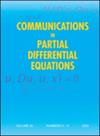∞-调和函数的流线服从逆平均曲率流
IF 1.7
2区 数学
Q1 MATHEMATICS
Communications in Partial Differential Equations
Pub Date : 2021-08-12
DOI:10.1080/03605302.2022.2109487
引用次数: 0
摘要
摘要给定域上的∞-调和函数,考虑函数If,然后很容易检查的流线是w的水平集,w求解了反平均曲率流的水平集公式。对于不太正则的解,这两种说法在一般情况下都不成立,但即使如此,在弱得多的假设下,w仍然是反平均曲率流的弱解。这是通过p-调和函数的近似,共轭调和函数的使用,以及共轭调和函数与反平均曲率流的已知联系来证明的。关于的规律性的陈述作为副产品出现。本文章由计算机程序翻译,如有差异,请以英文原文为准。
The streamlines of ∞-harmonic functions obey the inverse mean curvature flow
Abstract Given an ∞-harmonic function on a domain consider the function If with and then it is easy to check that the streamlines of are the level sets of w and w solves the level set formulation of the inverse mean curvature flow. For less regular solutions, neither statement is true in general, but even so, w is still a weak solution of the inverse mean curvature flow under far weaker assumptions. This is proved through an approximation of by p-harmonic functions, the use of conjugate -harmonic functions, and the known connection of the latter with the inverse mean curvature flow. A statement about the regularity of arises as a by-product.
求助全文
通过发布文献求助,成功后即可免费获取论文全文。
去求助
来源期刊
CiteScore
3.60
自引率
0.00%
发文量
43
审稿时长
6-12 weeks
期刊介绍:
This journal aims to publish high quality papers concerning any theoretical aspect of partial differential equations, as well as its applications to other areas of mathematics. Suitability of any paper is at the discretion of the editors. We seek to present the most significant advances in this central field to a wide readership which includes researchers and graduate students in mathematics and the more mathematical aspects of physics and engineering.

 求助内容:
求助内容: 应助结果提醒方式:
应助结果提醒方式:


